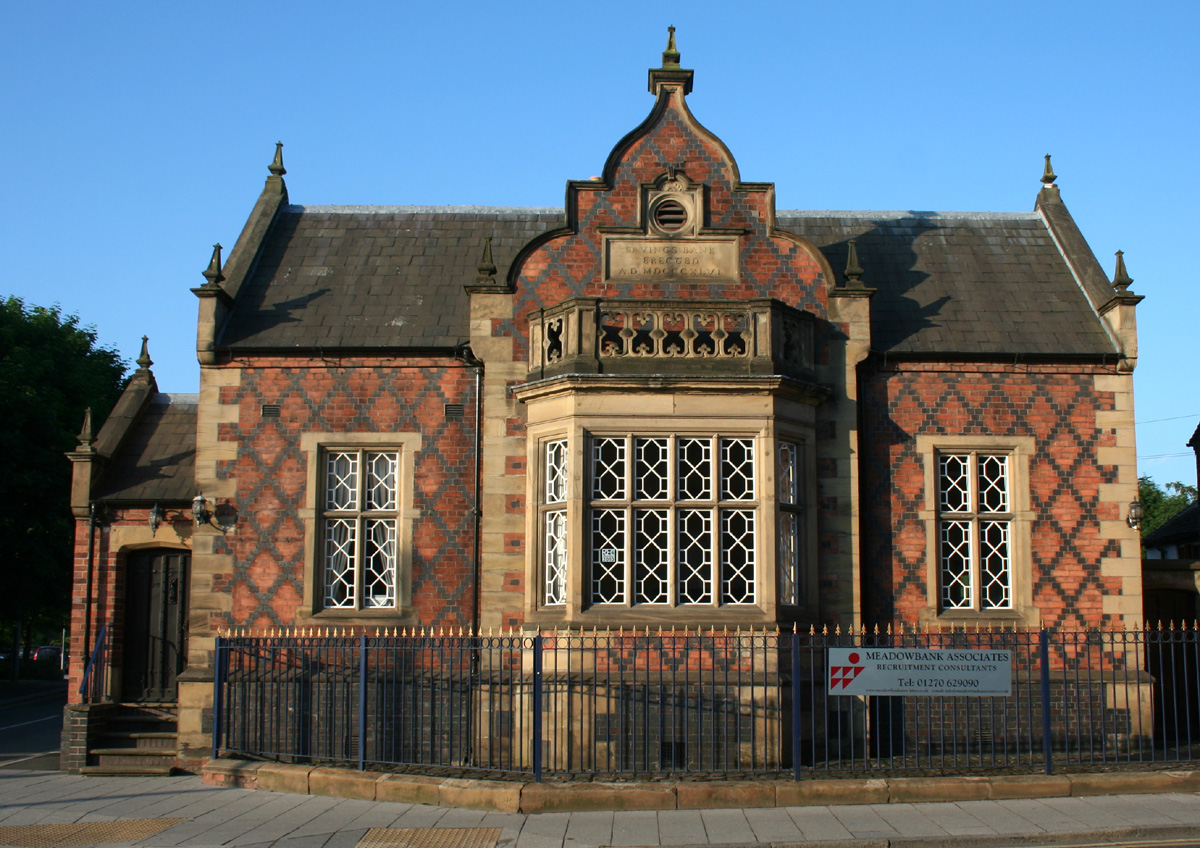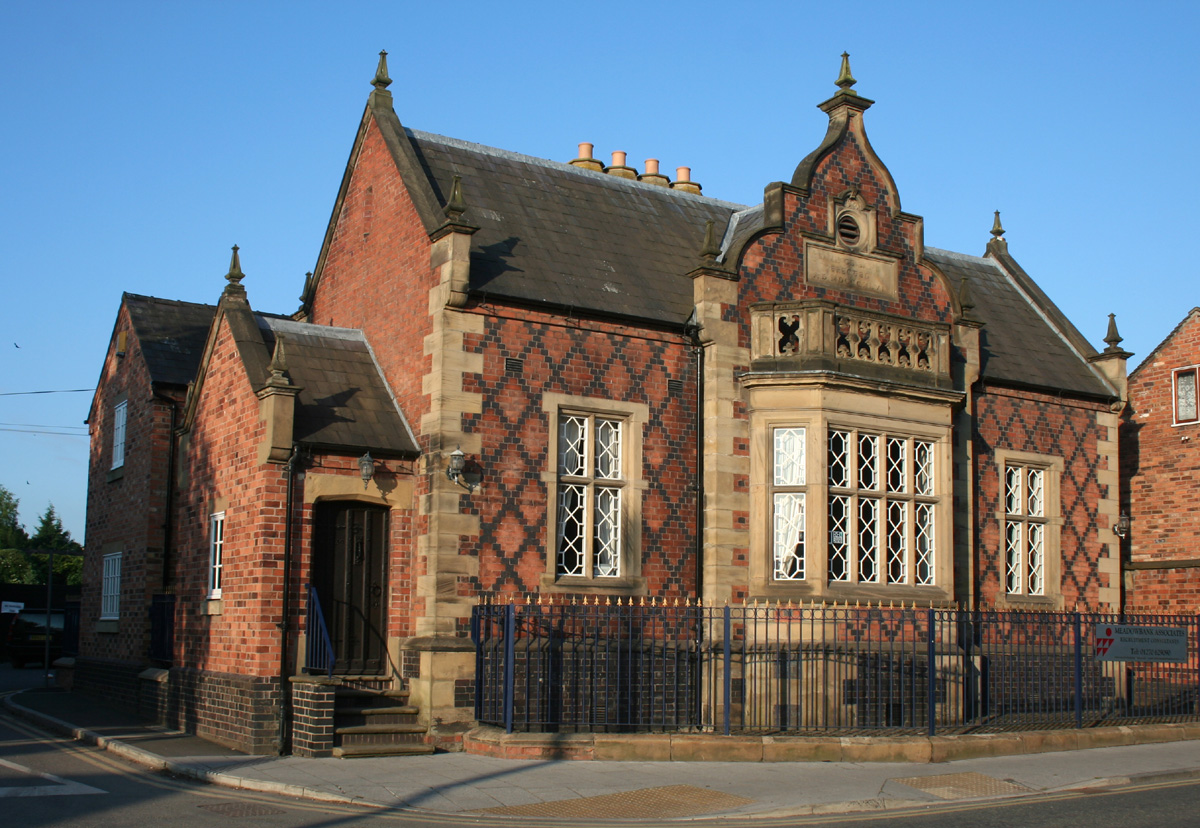39 Welsh Row, Nantwich on:
[Wikipedia]
[Google]
[Amazon]
 39 Welsh Row is a
39 Welsh Row is a
 The former bank is a detached single-storey building in
The former bank is a detached single-storey building in
 39 Welsh Row is a
39 Welsh Row is a Victorian
Victorian or Victorians may refer to:
19th century
* Victorian era, British history during Queen Victoria's 19th-century reign
** Victorian architecture
** Victorian house
** Victorian decorative arts
** Victorian fashion
** Victorian literature ...
former savings bank, in Jacobean Revival
The Jacobethan or Jacobean Revival architectural style is the mixed national Renaissance revival style that was made popular in England from the late 1820s, which derived most of its inspiration and its repertory from the English Renaissance (15 ...
style, in Nantwich, Cheshire, England. It stands on the south side of Welsh Row at the junction with St Anne's Lane (at ). Dating from 1846, it is listed at grade II
In the United Kingdom, a listed building or listed structure is one that has been placed on one of the four statutory lists maintained by Historic England in England, Historic Environment Scotland in Scotland, in Wales, and the Northern Irel ...
. Nikolaus Pevsner
Sir Nikolaus Bernhard Leon Pevsner (30 January 1902 – 18 August 1983) was a German-British art historian and architectural historian best known for his monumental 46-volume series of county-by-county guides, ''The Buildings of England'' (1 ...
describes number 39 as "the first noteworthy building" on Welsh Row, which he considers "the best street of Nantwich".Pevsner & Hubbard, p. 289 The street has many listed buildings and is known for its mixture of architectural styles, including timber-framed
Timber framing (german: Holzfachwerk) and "post-and-beam" construction are traditional methods of building with heavy timbers, creating structures using squared-off and carefully fitted and joined timbers with joints secured by large wooden ...
black-and-white cottages such as the Wilbraham's and Widows' Almshouses, Georgian
Georgian may refer to:
Common meanings
* Anything related to, or originating from Georgia (country)
** Georgians, an indigenous Caucasian ethnic group
** Georgian language, a Kartvelian language spoken by Georgians
**Georgian scripts, three scrip ...
town houses such as Townwell House and number 83, and Victorian buildings such as the former Grammar School
A grammar school is one of several different types of school in the history of education in the United Kingdom and other English-speaking countries, originally a school teaching Latin, but more recently an academically oriented secondary school ...
, Primitive Methodist Chapel and Tollemache Almshouses
The Tollemache Almshouses, also known as the Wilbraham Almshouses or Wilbraham's Almshouses, are six former almshouses in Nantwich, Cheshire, England. They are in two blocks of three cottages each, located on the north side of Welsh Row at num ...
.
39 Welsh Row is one of three banks in the town dating from the Victorian era which are listed buildings; the others are the former District Bank, designed by Alfred Waterhouse
Alfred Waterhouse (19 July 1830 – 22 August 1905) was an English architect, particularly associated with the Victorian Gothic Revival architecture, although he designed using other architectural styles as well. He is perhaps best known f ...
, and Barclays Bank
Barclays () is a British multinational universal bank, headquartered in London, England. Barclays operates as two divisions, Barclays UK and Barclays International, supported by a service company, Barclays Execution Services.
Barclays traces ...
, designed by Thomas Bower
Thomas Bower (1838–1919) was an English architect and surveyor based in Nantwich, Cheshire. He worked in partnership with Ernest H. Edleston at the Nantwich firm Bower & Edleston, which he founded in 1854.Pevsner & Hubbard, p. 288 He is pa ...
, both of which are on Churchyard Side. Number 39 is currently used as offices.
History
The Savings Bank was built in 1846, and cost an estimated £970.''Bagshaw's Directory'' (1850) Two earlier independent banks had been established in the town, but had proved short-lived, failing in 1816 and 1826. By 20 November 1848, the Savings Bank had 1079 deposits, of which 1064 were private, nine were from charitable societies and six from friendly societies. Savings banks were intended to assist the poor to save money for periods of hardship, and most deposits at that date were relatively modest, with nearly half no more than £20 (around £1,500 today), and only seven above £200 (£15,600 today). In 1850, it opened only twice monthly, on the first and third Monday of the month. It was then one of two banks in the town, the other being a branch of the Manchester and Liverpool District Bank on the High Street. By 1874, the bank was open weekly, on Mondays between 11 and 1. The Savings Bank was still at Welsh Row in 1914; however, by 1930 it had amalgamated with the Chester & Wrexham District Savings Bank and moved to 29 High Street. In the early 20th century the building was in a dilapidated condition. By 1971, 39 Welsh Row was used as offices for Pearl Assurance.Description
 The former bank is a detached single-storey building in
The former bank is a detached single-storey building in Jacobean Revival
The Jacobethan or Jacobean Revival architectural style is the mixed national Renaissance revival style that was made popular in England from the late 1820s, which derived most of its inspiration and its repertory from the English Renaissance (15 ...
style, set back from the street behind railings. In red brick under a slate roof, it has decorative blue-brick diapering and stone dressings on the Welsh Row (front) face. The central bay of the front face projects slightly and has a prominent shaped gable
A gable is the generally triangular portion of a wall between the edges of intersecting roof pitches. The shape of the gable and how it is detailed depends on the structural system used, which reflects climate, material availability, and aesth ...
, finished with a stone coping
Coping refers to conscious strategies used to reduce unpleasant emotions. Coping strategies can be cognitions or behaviours and can be individual or social.
Theories of coping
Hundreds of coping strategies have been proposed in an attempt to ...
and three triangular finial
A finial (from '' la, finis'', end) or hip-knob is an element marking the top or end of some object, often formed to be a decorative feature.
In architecture, it is a small decorative device, employed to emphasize the Apex (geometry), apex of a d ...
s; the gable contains a circular stone moulding, formerly a clock face, and a stone plaque inscribed "Savings Bank erected A.D. MDCCCXLVI". The central bay has a canted bay window
A bay window is a window space projecting outward from the main walls of a building and forming a bay in a room.
Types
Bay window is a generic term for all protruding window constructions, regardless of whether they are curved or angular, or r ...
surmounted by a stone balustrade
A baluster is an upright support, often a vertical moulded shaft, square, or lathe-turned form found in stairways, parapets, and other architectural features. In furniture construction it is known as a spindle. Common materials used in its con ...
with foliage decoration and cross-shaped openings. The flanking bays each have a single window, and all three windows to the front face have stone mullion
A mullion is a vertical element that forms a division between units of a window or screen, or is used decoratively. It is also often used as a division between double doors. When dividing adjacent window units its primary purpose is a rigid supp ...
s and transoms and hexagonal-latticed lights.
The main entrance is in a gabled porch attached to the St Anne's Lane (left) face; the doorway, reached by a short flight of stone steps, is undecorated and has a stone top. The sides of the Welsh Row face and the edges of the central bay have decorative stone quoin
Quoins ( or ) are masonry blocks at the corner of a wall. Some are structural, providing strength for a wall made with inferior stone or rubble, while others merely add aesthetic detail to a corner. According to one 19th century encyclopedia, t ...
s. The gable ends and the porch gable have stone corbel
In architecture, a corbel is a structural piece of stone, wood or metal jutting from a wall to carry a superincumbent weight, a type of bracket. A corbel is a solid piece of material in the wall, whereas a console is a piece applied to the s ...
s and coping, and are finished with triangular finials matching those on the central shaped gable.
Modern use
As of 2010, the building is used as the offices of arecruitment agency
An employment agency is an organization which matches employers to employees. In developed countries, there are multiple private businesses which act as employment agencies and a publicly-funded employment agency.
Public employment agencies
One ...
.
See also
*Listed buildings in Nantwich
Nantwich is a market town and civil parish in Cheshire East, Cheshire, England. It contains 132 listed buildings and structures, with three classified as grade I, seven as grade II* and 122 as grade II. In the United Kingdom, the ...
References
Sources *Bavington G ''et al''. ''Nantwich, Worleston & Wybunbury: A Portrait in Old Picture Postcards'' (Brampton Publications; 1987) () *Hall J. ''A History of the Town and Parish of Nantwich, or Wich Malbank, in the County Palatine of Chester'' (2nd edn) (E. J. Morten; 1972) () *Pevsner N, Hubbard E. ''The Buildings of England: Cheshire'' (Penguin Books; 1971) () *Simpson R. ''Crewe and Nantwich: A Pictorial History'' (Phillimore; 1991) () *Stevenson PJ. ''Nantwich: A Brief History and Guide'' (1994) *Vaughan D. ''Nantwich: It Was Like This'' (Nantwich Museum; 1987) {{coord, 53.0677, -2.5265, type:landmark_region:GB, display=title Commercial buildings completed in 1846 Nantwich, 39 Welsh Row Buildings and structures in Nantwich Grade II listed banks Jacobethan architecture 1846 establishments in England